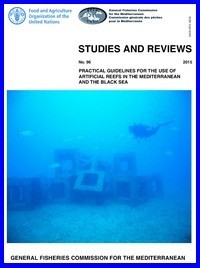General Fisheries Commission for Mediterranean
Study and Reviews No.96
Practical Guidelines for the use of Artificial Reefs in the Mediterranean and Black Sea
By
Gianna Fabi, Giuseppe Scarcella, Alessandra Spagnolo, Stephen A. Bortone, Eric Charbonnel, Juan J. Goutayer, Naoufel Haddad, Altan Lok and Michel Trommelen
Abstract
Artificial reefs have been used for a long time around the world and have served many purposes ranging from habitat restoration, fish stock enhancement and fisheries management to research and recreation, At present, fish stock enhancement and fisheries management are the main reasons driving reef construction in the Mediterranean Sea, while habitat restoration is the main purpose for their use in the Black Sea. The increasing interest for artificial reefs has given rise to several concerns regarding their possible negative impacts, due to the use of unsuitable materials and to waste dumping. Consequently, the need emerged over the past fifteen years to develop guidelines in the order to support managers and scientists in the use of artificial reefs in European seas. Based on such existing guidelines, this document aims to further provide up-to-date information and guidance regarding specific management practices for the planning, siting, construction and anchoring of artificial reefs in the Mediterranean and Black Sea and for monitoring their effectiveness from an ecological and and socio-economic point of view.
After providing an overview of existing definitions and legislations relating to the development of artificial reefs, this document illustrates the main aspects related to the different steps involved in the planning, siting and construction phases. A detailed presentation of the specific types and purposes of artificial reefs follows, with a description of their possible impacts and of existing methodologies to monitor and assess their effectiveness. Finally, these guidelines give insights about the socio-economic effects of artificial reefs and control, surveillance and maintenance issues.
Contents
1 – Introduction
<!--Defination of artificial reefs
<!--Objectives of artificial reefs
<!--Terminology
2 – International legislation on artificial reef deployment
3 – Planning
<!--Pre-construction phase
<!--Construction phase
<!--Post-construction phase
4 – Siting, design and construction of artificial reefs
<!--Site evauation for artificial reefs development
<!--Materials
<!--Types of reef structures
<!--Artificial reef dimensions
<!--Placement of the artificial structures
<!--Time of deployment
5 – Function-specific criteria
<!--Protection artificial reefs
<!--Production artificial reefs
<!--Recreational artificial reefs
<!--Restoration artificial reefs
<!--Multipurpose artificial reefs
6 – Possible negative impacts
7 – Methodologies to assess effectiveness and impacts of artificial reefs and standardized monitoring procedures
<!--Critical aspects in monitoring plans
<!--Monitoring methods
<!--Statistical framework
8 – Socio-economic effects of artificial reefs
<!--Socio-economic assessment
<!--Stakeholder analysis
9 - Artificial reefs management: control, surveillance and maintenance
<!--Protection artificial reefs
<!--Restoration artificial reefs
<!--Production, Recreational, and multipurpose artificial reefs.




ساحة النقاش